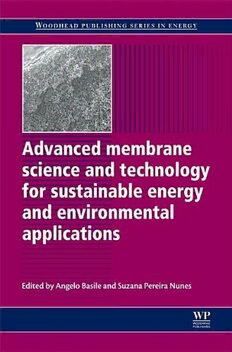
Advanced Membrane Science and Technology for Sustainable Energy and Environmental Applications (Woodhead Publishing Series in Energy) PDF
838 Pages·2011·20.776 MB·English
Most books are stored in the elastic cloud where traffic is expensive. For this reason, we have a limit on daily download.
Preview Advanced Membrane Science and Technology for Sustainable Energy and Environmental Applications (Woodhead Publishing Series in Energy)
Description:
Membranes are fundamentally designed to separate particular gases/liquids from other streams of gas/liquids, which presents an increasingly important and promising potential to both the conventional and alternative power sectors, as well as to clean industry applications. Advances in materials developments along with computer modeling and simulation have contributed greatly to this field, allowing for improved design and manufacture of selective membrane as critical components for such energy and environmental systems as gas processing, ion transport, osmosis and filtration. The demands of sustainable energy production and clean industry continue to drive membrane development toward the goal of simple, efficient, and easily integrated systems that offer low-cost, reliable processing and operation. This book presents a comprehensive review membrane science and technology, focusing on developments and applications in the areas of sustainable energy and clean-industry. The book initially deals with fundamental science and engineering of membrane design, development and manufacture, including operational issues, performance and economic analysis . Coverage continues with reviews of the main membrane application in the conventional energy and petrochemical industries, including membranes for carbon dioxide (CO2) and oxygen (O2) separation, along with fuel and flue gas processing. The alternative power sector is then considered, with review of fuel cell, electrolyser and battery membrane technology developments, as well as for hydrogen (H2) separation and osmotic applications. The final section reviews environmental and clean-industry applications, such as ultrafiltration and hazardous waste processing.
See more
The list of books you might like
Most books are stored in the elastic cloud where traffic is expensive. For this reason, we have a limit on daily download.
